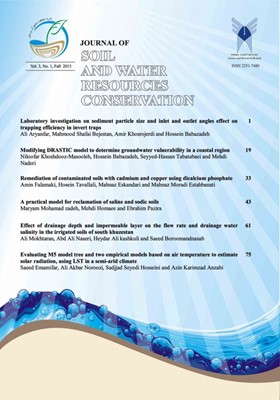Modifying DRASTIC model to determine groundwater vulnerability in a coastal region
Subject Areas : Farm water management with the aim of improving irrigation management indicators
Niloofar Khoshdooz-Masooleh
1
,
Hossein Babazadeh
2
![]() ,
Seyyed-Hassan Tabatabaei
3
,
Mehdi Naderi
4
,
Seyyed-Hassan Tabatabaei
3
,
Mehdi Naderi
4
1 - M.Sc. Graduated, Department of Water Engineering, College of Agriculture and Natural Resources, Tehran Science and Research Branch, Islamic Azad University, Tehran, Iran
2 - Assistant Professor, Department of Water Engineering, College of Agriculture and Natural Resources, Tehran Science and Research Branch, Islamic Azad University, Tehran, Iran,
3 - Associate Professor, Department of Water Engineering, Faculty of Agriculture, Shahrekord University, Shahrekord, Iran
4 - Assistant Professor, Department of Soil Science Engineering, Faculty of Agriculture, Shahrekord University, Shahrekord, Iran
Keywords: coastal aquifers, electrical conductivity (EC), modified DRASTIC model,
Abstract :
Coastal aquifers have a high potential for contamination by seawater intrusion. Thus, the vulnerability of groundwater resources can be very effective in identifying vulnerabilities and sensitive groundwater aquifers. This study was conducted to evaluate Kish island aquifer vulnerability. The DRASTIC model was employed and modified based on the coastal aquifer conditions. Two additional parameters were included to the model which describes the balance between seawater and aquifer water level. The vulnerability maps were produced by DRASTIC and M-DRASTIC models. The comparison of these maps was performed using EC and TDS as the main indicators. The required data were collected from the existing reports as well as some extra direct water sample measurements. The overlaying of the vulnerability map was obtained by the DRASTIC method. Comparison of M-DRASTIC with EC and TDS maps showed that the mean differences for DRASTIC map with EC map is 17.41 and 10.24, respectively and for M-DRASTIC is 0.69 and 0.55, respectively. This indicates that the M-DRASTIC model is more adapted to coastal zones. The vulnerability index in DRASTIC method is generally lower than M-DRASTIC range. Based on the M-DRASTIC vulnerability analysis, it was found that 17.8, 48.1 and 34.1 percents of Kish island area is under average, high and very high risk of groundwater contamination, respectively.


